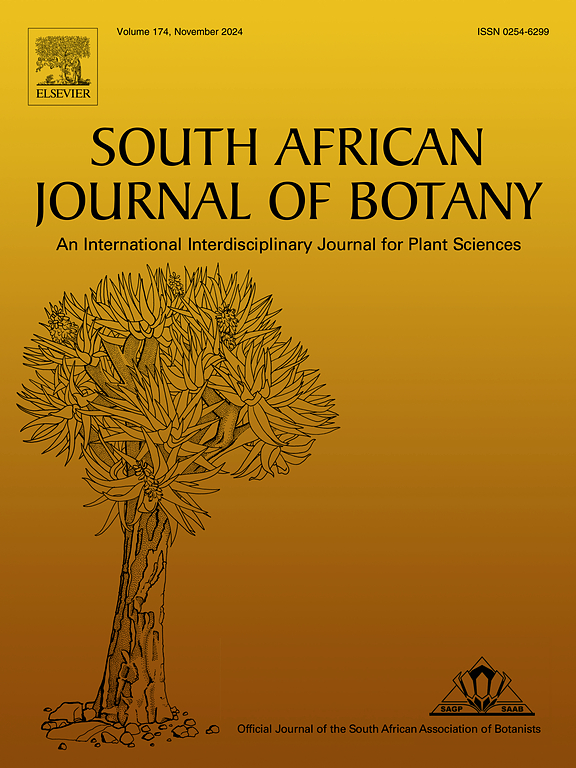Plant-based multi-target directed antitubercular ligand identification from Ipomea sepiaria with application of bioinformatics methodology
IF 2.7
3区 生物学
Q2 PLANT SCIENCES
引用次数: 0
Abstract
Tuberculosis (TB) remains a global health threat, with approximately 10.8 million cases reported worldwide in 2023. Complexities exist in the treatment strategies for TB because of the emergence of drug resistance, necessitating research to identify novel agents from natural sources to combat this ailment. Ipomea sepiaria, a perennial herb belonging to the tropical and subtropical regions rich with phytoconstituents, has been used traditionally to treat several diseases. However, the antitubercular potential of this herb has remained elusive. Hence, plant-based multi-target directed antitubercular ligand identification from I. sepiaria was carried out by extracting phytocompounds from the leaves using petroleum ether (PE), ethyl acetate (EA), ethanol, and water as solvents. The anti-mycobacterial potential of the extracts was screened using the Mycobacterium tuberculosis, H37Rv strain by luciferase reporter phage assay. GC–MS analysis followed by in silico molecular docking studies were carried out for the PE, EA, and ethanol extracts. PE and EA extracts showed equipotent (94.35 % inhibition) and mild (45.52 % inhibition) antitubercular activity. There were 16, 14, and 15 compounds identified in the PE, EA, and ethanolic extracts, respectively by GC–MS spectral analysis. Results indicated that the phytoconstituents isolated from the I. sepiaria leaves possess antitubercular activity with no/least toxicity. Overall, three compounds from the PE extract (PE11, PE12, PE14) and two from the EA extract (EA8, EA14) are being proposed as best lead-like phytocompounds based on drug-likeness, synthetic accessibility, and in silico/in vitro correlation. Further optimization studies are needed to develop these phytocompounds as novel antitubercular drugs.
应用生物信息学方法鉴定植物多靶点抗结核配体
结核病仍然是全球健康威胁,2023年全球报告的病例约为1080万例。由于耐药性的出现,结核病的治疗策略存在复杂性,因此需要进行研究,从自然来源确定新的药物来对抗这种疾病。麻豆属多年生草本植物,属热带和亚热带地区,富含植物成分,传统上用于治疗多种疾病。然而,这种草药的抗结核潜力仍然难以捉摸。因此,本研究以石油醚(PE)、乙酸乙酯(EA)、乙醇和水为溶剂,从金丝金莲叶片中提取植物化合物,进行了基于植物的多靶点定向抗结核配体鉴定。采用荧光素酶报告型噬菌体试验筛选结核分枝杆菌H37Rv菌株提取物的抗分枝杆菌活性。对PE、EA和乙醇提取物进行气相色谱-质谱分析,然后进行硅分子对接研究。PE和EA提取物的抗结核活性相当(抑制率为94.35%),轻度(抑制率为45.52%)。通过GC-MS分析,分别鉴定出PE、EA和乙醇提取物中的16、14和15个化合物。结果表明,从海苔叶中分离得到的植物成分具有抗结核活性,且无毒性或毒性最小。总的来说,基于药物相似性、合成可及性和硅/体外相关性,来自PE提取物的3个化合物(PE11、PE12、PE14)和来自EA提取物的2个化合物(EA8、EA14)被认为是最好的类铅植物化合物。需要进一步的优化研究来开发这些植物化合物作为新的抗结核药物。
本文章由计算机程序翻译,如有差异,请以英文原文为准。
求助全文
约1分钟内获得全文
求助全文
来源期刊

South African Journal of Botany
生物-植物科学
CiteScore
5.20
自引率
9.70%
发文量
709
审稿时长
61 days
期刊介绍:
The South African Journal of Botany publishes original papers that deal with the classification, biodiversity, morphology, physiology, molecular biology, ecology, biotechnology, ethnobotany and other botanically related aspects of species that are of importance to southern Africa. Manuscripts dealing with significant new findings on other species of the world and general botanical principles will also be considered and are encouraged.
 求助内容:
求助内容: 应助结果提醒方式:
应助结果提醒方式:


